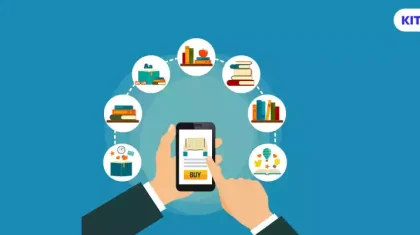
Emerging eLearning Technologies for Associations and Non-profits
Summarize this blog with your favorite AI:
Early eLearning often lacked dynamism, relying heavily on linear presentations that failed to engage learners. The ‘one-size-fits-all’ approach was appropriate when technology penetration was yet to start, but it will not be enough in today’s dynamic picture. Innovative technologies are now revolutionizing the eLearning experience.
Applying artificial intelligence, virtual reality, and gamification will transform knowledge delivery to interact and learn in new ways. We will see how associations and non-profits can utilize these emerging technologies to provide transformative learning experiences that have a high impact.
Table of Contents:
I. Mastering the eLearning Landscape
II. Key Emerging eLearning Technologies
- Artificial Intelligence (AI) in eLearning
- Virtual Reality (VR) and Augmented Reality (AR) in eLearning
- Gamification
- Microlearning
- Blockchain Technology
III. Conclusion
Mastering the eLearning Landscape
The eLearning environment is always changing. Emerging technologies are getting stronger, providing associations and non-profit organizations with tremendous opportunities to enhance their educational programs and reach their audience in more effective ways.
These changes have made eLearning no longer uniform but rather a model that puts the focus on the learners. That way, it can take into consideration diversity and varied options. Several fundamental factors drive these changes:
1. Shifting Learner Expectations
Today’s learners have evolved significantly. They are:
- Tech-savvy: Born and brought up in the digital world, they are quite comfortable with technology and expect seamless digital experiences.
- Demand-driven: Looking for flexibility and convenience in learning, according to their busy schedule. A survey revealed that 94% of learners prefer self-paced learning options.
- Experience-oriented: Interested in interactive and experience-based learning instead of passive content consumption.
2. The Rise of Personalized Learning
Some of the most recent trends include personalization through learning techniques powered by:
- AI-based analysis: AI algorithms analyze learner data such as learning styles, pace, and performance to adjust learning paths to individual needs.
- Adaptive learning: Learning platforms adapt at a real-time learning pace, with more support or challenging content publishing if needed.
- Personalized feedback: The AI-based tools give the learners personalized feedback on where they can improve, keeping them motivated.
Key Emerging eLearning Technologies
The global eLearning market is estimated to reach an incredible USD 848.12 billion by 2030. This explosive growth is being driven by innovative technologies coming up at a pace that drastically changes the learning landscape. Beyond augmenting the experience of learning, the technologies are enabling unprecedented access to education while shaping the very future of learning :
1. Artificial Intelligence (AI) in eLearning
Artificial intelligence (AI) is revolutionizing the eLearning technology tools by personalizing the learning experience. AI-powered tools, integrated within digital textbook platforms such as KITABOO, can analyze huge amounts of learner data, including learning styles, pace, and performance history.
This data-driven analysis enables the platform to provide personalized recommendations, such as suggesting relevant learning resources, adjusting the difficulty level of content, and creating customized learning paths.
In addition, AI chatbots are gradually becoming smarter and more complex. These smart assistant tools can automatically provide learners with instant support answers to most questions asked, guide learners according to their individual preferences, and provide other similar assistance, all without an apparent struggle through the learning platform’s interface.
2. Virtual Reality (VR) and Augmented Reality (AR) in eLearning
Virtual and augmented reality are becoming powerful tools that can make learning more immersive and interactive. Using VR technology, learners can be transported into simulated environments to practice real-world scenarios in a safe and controlled setting.
Augmented reality adds a digital information layer to real-world environments, which can be extremely useful in training and skill acquisition. For example, a technician could be trained to repair intricate machinery using overlays that contain step-by-step instructions and indicate important parts.
3. Gamification
Gamification involves incorporating game mechanics into the learning process, helping to transform the otherwise passive process into an engaging and rewarding one. This includes points, badges, leaderboards, and challenges, which increase learner motivation and engagement. By sensing accomplishment and progress, learners are more willing to sustain their learning and pursue mastery.
Integration into gamified elements with KITABOO can combine learning and content delivery mechanisms. It awards points when learning modules are complete, issues badges when certain markers are achieved, and encourages leaderboards that support friendly competition in learning. One can use challenges and rewards unique to a progressive learning model.
4. Microlearning
Busy professionals hardly have time for long training courses. Microlearning addresses the issue of short attention spans by delivering learning content in easily digestible chunks. Microlearning modules usually consist of brief videos, interactive quizzes, infographics, or short articles, each focusing on one specific learning objective.
The content is best suited to the KITABOO application because it allows microlearning to create and deliver experiences in small, bite-sized modules that are easily accessible and consumed on any number of devices. Microlearning will cater to learners’ busy schedules and also improve knowledge retention because the information delivered is concise yet engaging.
5. Blockchain Technology
Blockchain technology is known for being secure and transparent. It can revolutionize the education sector by helping enhance its systems’ security and integrity.
The most essential application is checking the credentials for the authenticity of learning materials. Blockchain creates an immutable and tamper-proof record of academic achievements, making it very difficult to commit fraud and forgeries on academic results. This allows students to safely store their diplomas, certificates, and transcripts on the blockchain, and then employers or any other institution can verify them simply and efficiently.
Conclusion
New eLearning technologies are offering associations and non-profits a thrilling chance to elevate their educational programs. They can make their learning experiences more interesting, effective, and impactful by embracing these new technologies and online platforms.
Associations and non-profits can now unlock the full potential of emerging eLearning technologies through cutting-edge cloud-based learning platforms such as KITABOO. Contact us today to learn how we can better help you.
Also check:
- Digital Textbook Platform for K12 Publishers
- Digital Textbook Platform for Associations & Societies
- Digital Textbook Platform for Trade Publishers
- Digital Textbook Platform for Training Companies
- Digital Publishing Solution for Content Aggregators
- Digital Publishing Platform for Professional Training
Discover how a mobile-first training platform can help your organization.
KITABOO is a cloud-based platform to create, deliver & track mobile-first interactive training content.



